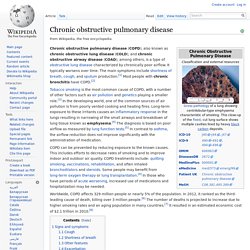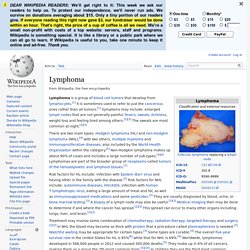

Cancer. Skin Cancer. Scoliosis. Scoliosis (/ˌskɒlɪˈoʊsɪs/;[1] from Ancient Greek: σκολίωσις skoliosis “obliquity, bending”[2]) is a medical condition in which a person's spine is curved from side to side.

Although it is a complex three-dimensional deformity, on an X-ray, viewed from the rear, the spine of an individual with scoliosis can resemble an "S" or a "? ", rather than a straight line.[3] Scoliosis is typically classified as either congenital (caused by vertebral anomalies present at birth), idiopathic (cause unknown, sub-classified as infantile, juvenile, adolescent, or adult, according to when onset occurred), or secondary to a primary condition.[4] Secondary scoliosis can be the result of a neuromuscular condition (e.g., spina bifida, cerebral palsy, spinal muscular atrophy, or physical trauma) or syndromes such as Chiari malformation.[4] Signs and symptoms[edit] 20th century illustration of a severe case of scoliosis.
People having reached skeletal maturity are less likely to have a worsening case. Oh good, a freaky brain parasite has found its way to the Arctic. Cystic fibrosis. Cystic fibrosis (CF), also known as mucoviscidosis, is an autosomal recessive genetic disorder that affects most critically the lungs, and also the pancreas, liver, and intestine.

It is characterized by abnormal transport of chloride and sodium across an epithelium, leading to thick, viscous secretions.[1] The name cystic fibrosis refers to the characteristic scarring (fibrosis) and cyst formation within the pancreas, first recognized in the 1930s.[2] Difficulty breathing is the most serious symptom and results from frequent lung infections that are treated with antibiotics and other medications. Other symptoms—including sinus infections, poor growth, and infertility—affect other parts of the body. CF is caused by a frameshift mutation in the gene [3] for the protein cystic fibrosis transmembrane conductance regulator (CFTR). Chronic obstructive pulmonary disease.
Chronic obstructive pulmonary disease (COPD), also known as chronic obstructive lung disease (COLD), and chronic obstructive airway disease (COAD), among others, is a type of obstructive lung disease characterized by chronically poor airflow.

It typically worsens over time. The main symptoms include shortness of breath, cough, and sputum production.[1] Most people with chronic bronchitis have COPD.[2] Tobacco smoking is the most common cause of COPD, with a number of other factors such as air pollution and genetics playing a smaller role.[3] In the developing world, one of the common sources of air pollution is from poorly vented cooking and heating fires. COPD can be prevented by reducing exposure to the known causes. This includes efforts to decrease rates of smoking and to improve indoor and outdoor air quality.
Worldwide, COPD affects 329 million people or nearly 5% of the population. Mosquito-borne diseases, infectious disease information, NCID, CDC. Mosquito facts: 10 things you didn't know. Hematoma. A hematoma or haematoma, is a localized collection of blood outside the blood vessels,[1] usually in liquid form within the tissue.

Necrotizing fasciitis. Necrotizing fasciitis (/ˈnɛkrəˌtaɪzɪŋ ˌfæʃiˈaɪtɪs/ or /ˌfæs-/) or NF, commonly known as flesh-eating disease or flesh-eating bacteria syndrome,[1] is a rare infection of the deeper layers of skin and subcutaneous tissues, easily spreading across the fascial plane within the subcutaneous tissue.

The most consistent feature of Necrotizing Fasciitis was first described in 1952 by Wilson, as necrosis of the subcutaneous tissue and fascia with relative sparing of the underlying muscle.[2] Necrotizing fasciitis progresses rapidly, having greater risk of developing in the immunocompromised due to conditions such as diabetes or cancer. It is a severe disease of sudden onset and is usually treated immediately with surgical debridement and high doses of intravenous antibiotics,[3] with delay in surgical treatment being associated with higher mortality. Inflammatory bowel disease. Classification[edit] The main forms of IBD are Crohn's disease and ulcerative colitis (UC).

Inflammatory bowel diseases are considered autoimmune diseases, in which the body's own immune system attacks elements of the digestive system.[4] Encephalopathy. Encephalopathy /ɛnˌsɛfəˈlɒpəθi/ means disorder or disease of the brain.[1] In modern usage, encephalopathy does not refer to a single disease, but rather to a syndrome of global brain dysfunction; this syndrome can have many different organic and inorganic causes.

Terminology[edit] In some contexts it refers to permanent (or degenerative)[2] brain injury, and in others it is reversible. It can be due to direct injury to the brain, or illness remote from the brain. In medical terms it can refer to a wide variety of brain disorders with very different etiologies, prognoses and implications. Ludwig's angina. Ludwig's angina, otherwise known as angina ludovici, is a serious, potentially life-threatening cellulitis[1][dead link], or connective tissue infection, of the floor of the mouth, usually occurring in adults with concomitant dental infections and if left untreated, may obstruct the airways, necessitating tracheotomy.

It is named after the German physician, Wilhelm Friedrich von Ludwig who first described this condition in 1836.[2][3] Other names include "angina Maligna" and "Morbus Strangularis". Ludwig's angina should not be confused with angina pectoris, which is also otherwise commonly known as "angina". The word "angina" comes from the Greek word ankhon, meaning "strangling", so in this case, Ludwig's angina refers to the feeling of strangling, not the feeling of chest pain, though there may be chest pain in Ludwig's angina if the infection spreads into the retrosternal space.
Causes[edit] Cardiomyopathy. Cardiomyopathy (literally "heart muscle disease") is the measurable deterioration of the function of the myocardium (the heart muscle) for any reason, usually leading to heart failure; common symptoms are dyspnea (breathlessness) and peripheral edema (swelling of the legs).

People with cardiomyopathy are often at risk of dangerous forms of irregular heart beat and sudden cardiac death.[1] The most common form of cardiomyopathy is dilated cardiomyopathy.[2][3] Classification[edit] Although in theory the term "cardiomyopathy" could apply to almost any disease affecting the heart, in practice it is usually reserved for "severe myocardial disease leading to heart failure".[4] An extrinsic cardiomyopathy is a cardiomyopathy where the primary pathology is outside the myocardium itself.
Most cardiomyopathies are extrinsic, by far the most common cause of an extrinsic cardiomyopathy is ischemia. Lymphoma. Lymphoma is a group of blood cell tumors that develop from lymphocytes.[1] It is sometimes used to refer to just the cancerous ones rather than all tumors.[1] Symptoms may include: enlarged lymph nodes that are not generally painful, fevers, sweats, itchiness, weight loss and feeling tired among others.[2][3] The sweats are most common at night.[2][3] There are two main types: Hodgkin lymphoma (HL) and non-Hodgkin lymphoma (NHL),[4] with two others, multiple myeloma and immunoproliferative diseases, also included by the World Health Organization within the category.[5] Non-Hodgkin lymphoma makes up about 90% of cases and includes a large number of sub-types.[4][6] Lymphomas are part of the broader group of neoplasms called tumors of the hematopoietic and lymphoid tissues.[7] Signs and symptoms[edit] Lymphoma and lymphatic system Lymphoma presents with certain non-specific symptoms.

If symptoms are persistent, lymphoma needs to be excluded medically. Melanoma. Melanoma ( i/ˌmɛləˈnoʊmə/; from Greek μέλας melas, "dark")[1] is a malignant tumor of melanocytes.[2] Melanocytes produce the dark pigment, melanin, which is responsible for the color of skin. These cells predominantly occur in skin, but are also found in other parts of the body, including the bowel and the eye (see uveal melanoma). Melanoma can originate in any part of the body that contains melanocytes. Melanoma is less common than other skin cancers. Beck's triad (cardiology) Beck's triad is a collection of three medical signs associated with acute cardiac tamponade, an emergency condition wherein fluid accumulates around the heart and impairs its ability to pump blood. The signs are low arterial blood pressure, distended neck veins, and distant, muffled heart sounds.[1] Narrowed pulse pressure might also be observed.
The concept was developed by Claude Beck, a resident and later Professor of Cardiovascular Surgery at Case Western Reserve University.[2] The rising central venous pressure is evidenced by distended jugular veins while in a non-supine position. It is caused by reduced diastolic filling of the right ventricle, due to pressure from the adjacent expanding pericardial sac. Trisomy. Leukemia. Leukemia (American English) or leukaemia (British English) is a type of cancer of the blood or bone marrow characterized by an abnormal increase of immature white blood cells called "blasts".
Leukemia is a broad term covering a spectrum of diseases. In turn, it is part of the even broader group of diseases affecting the blood, bone marrow, and lymphoid system, which are all known as hematological neoplasms. Leukemia can affect people at any age. In 2000 approximately 256,000 children and adults around the world had developed some form of leukemia, and 209,000 have died from it.[1] About 90% of all leukemias are diagnosed in adults.[2] The name comes from Ancient Greek λευκός leukos "white", and αἷμα haima "blood"[3]
Emerald cockroach wasp. Distribution[edit] The wasp is mostly found in the tropical regions of South Asia, Africa and the Pacific islands. The flying wasps are more abundant in the warm seasons of the year. Ménière's disease. Signs and symptoms[edit] Audiograms illustrating normal hearing (left) and unilateral low-pitch hearing loss associated with Ménière's disease (right). Ménière's often begins with one symptom, and gradually progresses. Hyperprolactinaemia. Acute intermittent porphyria. Multiple sclerosis. Ectopic pregnancy. Non-Hodgkin lymphoma. Huntington's disease.